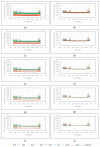Long-Term Assessment of a Set of CO2 Concentration Sensors in an In-Use Office Building
- PMID: 36502106
- PMCID: PMC9736409
- DOI: 10.3390/s22239403
Long-Term Assessment of a Set of CO2 Concentration Sensors in an In-Use Office Building
Abstract
The measurement of the CO2 concentration has a wide range of applications. Traditionally, it has been used to assess air quality, with other applications linked to the experimental assessment of occupancy patterns and air renewal rates. More recently, the worldwide dissemination of COVID-19 establishing a relationship between infection risk and the mean CO2 level has abruptly led to the measurement of the CO2 concentration in order to limit the spread of this respiratory disease in the indoor environment. Therefore, the extensive application of this measurement outside of traditional air quality assessment requires an in-depth analysis of the suitability of these sensors for such modern applications. This paper discusses the performance of an array of commercial wall-mounted CO2 sensors, focusing on their application to obtain occupancy patterns and air renovation rates. This study is supported by several long-term test campaigns conducted in an in-use office building located in south-eastern Spain. The results show a spread of 19-101 ppm, with a drift of 28 ppm over 5 years, an offset of 2-301 ppm and fluctuations up to 80 ppm in instantaneous measurements not related to concentration changes. It is proposed that values averaged over 30 min, using a suitable reference value, be used to avoid erroneous results when calibration is not feasible.
Keywords: CO2 concentration; building energy; in situ measurements; long-term measurements; performance gap.
Conflict of interest statement
The authors declare no conflict of interest. The funders had no role in the design of the study; in the collection, analyses or interpretation of data; in the writing of the manuscript; or in the decision to publish the results.
Figures






References
-
- Villanueva F., Notario A., Cabañas B., Martín P., Salgado S., Fonseca Gabriel M. Assessment of CO2 and aerosol (PM2.5, PM10, UFP) concentrations during the reopening of schools in the COVID-19 pandemic: The case of a metropolitan area in Central-Southern Spain. Environ. Res. 2021;197:111092. doi: 10.1016/j.envres.2021.111092. - DOI - PMC - PubMed
-
- Aguilar A.J., de la Hoz-Torres M.L., Martínez-Aires M.D., Ruiz D.P. Monitoring and Assessment of Indoor Environmental Conditions after the Implementation of COVID-19-Based Ventilation Strategies in an Educational Building in Southern Spain. Sensors. 2021;21:7223. doi: 10.3390/s21217223. - DOI - PMC - PubMed
-
- de la Hoz-Torres M.L., Aguilar A.J., Ruiz D.P., Martínez-Aires M.D. Analysis of Impact of Natural Ventilation Strategies in Ventilation Rates and Indoor Environmental Acoustics Using Sensor Measurement Data in Educational Buildings. Sensors. 2021;21:6122. doi: 10.3390/s21186122. - DOI - PMC - PubMed
-
- Pei G., Rim D., Schiavon S., Vannucci M. Effect of sensor position on the performance of CO2-based demand controlled ventilation. Energy Build. 2019;202:109358. doi: 10.1016/j.enbuild.2019.109358. - DOI
-
- Mou J., Cui S., Khoo D.W.Y. Computational fluid dynamics modelling of airflow and carbon dioxide distribution inside a seminar room for sensor placement. Meas. Sensors. 2022;23:100402. doi: 10.1016/j.measen.2022.100402. - DOI
MeSH terms
Substances
Grants and funding
LinkOut - more resources
Full Text Sources
Medical
Miscellaneous

